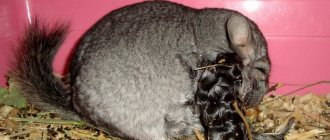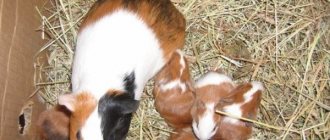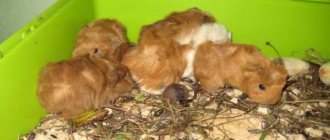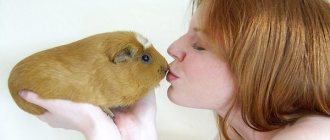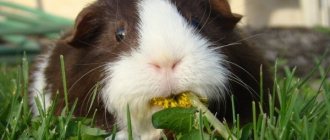Matching
It all starts with the selection of future parents. They must be the same breed. It is not permissible to breed guinea pigs of different breeds. Otherwise, you can get mestizos, not purebred offspring.
In addition, pigs are also selected for their fur. Both parents should have the same length. This does not mean that you have to measure every hair with a ruler. Just choose short-haired or long-haired pigs. Crossing individuals with different hair lengths is not recommended.
The main emphasis is on the health of future parents. It can be determined visually, but it is better to contact a veterinarian. At the veterinary clinic, you can do the necessary tests and make sure that your pigs are in excellent health.
The animals that are planned to be bred must look good. Clean coat and clear eyes are signs of health. This also includes the fatness of pigs and their mobility.
Photo from gallery
Dried fruits
Dried fruits are full of natural sugars that are harmless in small doses, but unsafe in large doses. If you often give your animal dried fruits, be prepared for the fact that he will develop diabetes, suffer from toothache and skin rashes.
In addition, dried fruits in excessive quantities disrupt the functioning of the intestinal tract and prevent proper grinding of teeth. By swelling, dry fruits give a feeling of fullness, in which the animal is less interested in hay, which is responsible for both the activity of the gastrointestinal tract and the grinding of teeth.
Age for mating
Guinea pigs become sexually mature early. At the age of 5-7 weeks they are ready for mating. This applies to both sexes.
The female's first heat lasts a day. Occurs every 14-20 days. You cannot knit a “young lady” who is too young. Mating is also not beneficial for a young male. It is not the parents who will suffer the most, but the cubs. The “piglets” that are born will have deviations. It could be:
- Blindness.
- Deafness.
- Complete absence of eyes.
- Problems with internal organs.
- Incorrect growth of teeth.
The optimal age for mating is from 4 months to a year. This applies to females. She should give birth for the first time during this time period. The first birth after a year can have serious consequences.
As for the male, he is bred at 5-7 months. This age is considered ideal.
Mating
For one male there should be from 5 to 10 female pigs. Some breeders keep them together, others separately - there is no fundamental difference. In the case of separate keeping, the female during estrus is placed in a cage with a “man”.
The hunt lasts about two days, the frequency of estrus is 13-20 days. The favorable period for fertilization lasts about 10 hours. The female takes a characteristic pose (she is motionless, her hind legs are apart, her croup is raised) and is ready to let her partner approach her.
Before babies are born
Before giving birth, your guinea pig's behavior changes. She becomes lethargic and sleepy. It can lie in its nest for hours. He refuses food, but drinks with great desire. Experienced breeders recommend giving the animal a rosehip decoction. Of course, it needs to be cooled. Two drinking bowls are installed in the cage. One for clean water, the second for rose hips.
As mentioned above, the expectant mother refuses to eat, but does not disdain her favorite delicacy. Treat it to whatever the animal likes.
A week before the birth, the male is removed (if the couple lived together before). The pig needs complete rest, it is advisable not to touch it again. Temporarily you will have to forget about picking up your pet.
Pregnancy period
Length of pregnancy
Average time is about 10 weeks. The duration of this period can be affected by the animal’s age, breed, number of fetuses, as well as the health characteristics of a particular female. Of course, if there are two or more babies in the tummy, then the gestation period will be reduced to 58-62 days. When the baby is the only one – 70-75 days.
Number of cubs
If a guinea pig becomes a mother for the first time, it often means 1, maximum 2 babies. In case of repeated pregnancy, the probable number of children is 2-5.
Unlike hamsters, guinea pigs are born with their eyes open and fur. Which makes them somewhat independent from their mother.
Caring for your pig during pregnancy
The owner’s task is to create a comfortable, calm environment for the expectant mother, so that the pregnancy proceeds well and the birth occurs on time. Loud sounds and noise should be avoided, and you should also avoid picking up the pig often.
There is a set of simple but important recommendations:
- As soon as it becomes clear that the guinea pig is pregnant, you need to transplant it from the male and other neighbors into a separate cage. This is necessary for a calm environment, and to avoid re-mating immediately after childbirth.
- Leave only the essentials in the cage - a drinking bowl, a bowl of food, a house. Remove ladders, swings, etc., eliminating the risk of injury.
- The cage should be located in a place where there are no drafts, no sudden changes in temperature, no direct sunlight, as this can cause toxicosis in the animal, even death.
- Bathing should be avoided during pregnancy, so as not to further frighten the animal.
- Do not pull the female out of the cage unless necessary, but if necessary, this should be done carefully, with both hands, supporting the tummy.
- Skin care may be required as cracks may appear on the abdomen. It is enough to lubricate with baby cream. If the breed is long-haired, then at the beginning of pregnancy you should cut the hair so that it does not get dirty.
- It is recommended to replace the hay bedding with fresh hay daily and wash bowls and drinking bowls. The cleaning process should take place calmly, again, so as not to scare the animal.
- If the pet is not shy and shows interest, then short walks outside the cage are allowed to maintain activity and prevent possible obesity.
- You should only visit a veterinarian if there are any disturbances in behavior or well-being.
Diet of a pregnant animal
It is very important not only to increase the diet depending on the period, but also to make it complete and balanced. It is during pregnancy that pigs lack vitamin C and calcium, which are very important for future offspring. Monitor the availability of clean water in the drinking bowl.
In addition to the usual food, hay, fresh vegetables, herbs and fruits, the guinea pig's menu should include:
- Dairy products (cottage cheese, milk);
- Specialized food for pregnant pigs.
Refusal to eat after delivery is a signal that you urgently need to visit a veterinary clinic. The cause may be serious health problems.
Preparatory process
Childbirth in a guinea pig is quiet. This happens if the female has experience. We will talk about possible complications below.
A week before the birth, the cage is thoroughly cleaned. It is completely thoroughly washed. Feeders and drinking bowls are disinfected. The old filler is removed. The new one is covered with a thick layer. The pig gets hay and a clean cloth for the nest, although cloth can be dispensed with.
If the animal’s pelvis has expanded and the genitals have taken on a convex shape, this indicates that labor is imminent. Breeders say that before the process, the females’ vaginal membrane disappears. This is a film that covers it during pregnancy.
What to feed
The diet plays an important role in the life of a pregnant female; the health and well-being of the mother and cubs depends on it; in addition, the full formation and growth of the fetus depends on food.
Animal food should contain a variety of vitamins and microelements. But remember that you cannot overfeed your pet, as this can lead to obesity; introduce more vegetables and fruits into the diet.
So, let's take a closer look at what the diet should be like:
- Granular feed. It is an excellent option because it contains the necessary nutrients. But you should never overfeed, be sure to read the instructions and do not increase the portions.
- Hay. It contains calcium and protein, which are so necessary for the proper development of the fetus, it should be available daily.
- Water. Be sure to change the water as often as possible; it is advisable to install several drinkers so that there is constant water.
- Vegetables. Vegetables are an excellent source of vitamins and minerals, and they don’t make you gain weight; give them carrots, cucumbers, corn, etc.
- Herbs. Another source of vitamins and microelements that are of great benefit, give the female clover leaves, parsley, and other herbs, but make sure the plants are fresh.
- Fruits. They can also be beneficial, but only if they are given rarely and in small quantities; they are more of a treat for the animal; you can treat him to an apple, strawberry, raspberry and other ripe and juicy fruits.
- Cottage cheese, milk. These products are very important for females during pregnancy; they are given once a week.
- Vitamin E. A very important element for the health of the female and cubs, it is found in wheat and oats, so you should make sure that they are in the diet.
- Vitamin C. Another important element that is found in food, there is a lot of it in tomato juice. Make the menu in such a way that it contains products containing this vitamin.
- Vitamins and minerals. Now there are special vitamin supplements, including for pregnant females, that provide the body with everything it needs. The veterinarian will help you choose the most suitable option.
The process has started
How do guinea pigs give birth? Very quiet and unnoticeable. The pet begins to give birth late at night or closer to the morning. She chooses a secluded corner in the cage. It does not make any sounds during the process. However, first-born females can squeak, but they do it very quietly.
The expectant mother squats down. A baby is born. It is located in the amniotic sac. The female tears it apart and eats it. The placenta and umbilical cord are destroyed in the same way.
Childbirth in a guinea pig proceeds quickly. Babies are born at intervals of 4-6 minutes. There are 4-5 cubs in a litter. It's rare that six babies are born.
Development of baby guinea pigs by day
Newborn pigs develop rapidly. In the first days of life, they gain 4-6 g in weight. Then growth accelerates. On the 5th-6th day, the baby’s body weight increases by an average of 25 g. At two weeks of age, the weight of the cubs doubles.
Rapid growth is observed up to 2 months. At 8 weeks the weight of the rodent is 350-400 g. Then development slows down, but the animal continues to grow until it is one year old. An adult female weighs about 500-700 g, and a male weighs at least 900 g.
The little ones were born
The birth of a guinea pig (you can see the babies in the photo below) goes quickly. Cubs are born prepared for a new life.
They have fur like adults. The eyes of newborns are open, and a couple of hours after birth, the baby begins to walk around the cage. After two to three days, the offspring begins to eat “adult” food, but they feed on mother’s milk until they are one month old.
Complications during childbirth
How to help a guinea pig during childbirth? There are very rarely situations when a pet requires intervention from the owner. She handles the process herself.
But sometimes there are risks. If the female is pushing and the babies are in no hurry to be born, this is a reason for intervention. The best solution is to call a veterinarian. Otherwise, the mother and the babies will die.
If the baby is stuck in the birth canal, the situation requires immediate intervention. The pig's owner must help her. Let us warn you right away that the newborn is unlikely to survive, but the female will be saved.
The owner washes his hands thoroughly. Inserts two fingers into the pet’s vagina and feels the fetal head. You need to grab it with your fingers and pull it very carefully. It is better to do this at the same time as the female is pushing.
An inexperienced mother may refuse to bite the umbilical cord. She is frightened by the painful process. She has no time to free the baby from the amniotic sac. The owner takes on this function.
It is necessary to wrap the baby in a napkin. The amniotic sac is torn. The cub is wiped dry. The umbilical cord is cut with nail scissors. After all the manipulations, the newborn is placed next to the mother’s nipples.
Postpartum complications
We found out how to give birth to a guinea pig. As a rule, they do not require intervention. We talked about actions in an unforeseen situation.
The female may experience postpartum complications. If she refuses to eat, this is not yet a cause for alarm. Some people don’t eat for several hours after giving birth, but they don’t give up their favorite treat. In case of a lethargic appearance and an unwillingness to eat absolutely nothing, it is necessary to call a veterinarian.
Sometimes there is slight bleeding. It can last for several days. There are few allocations. If bleeding is heavy, especially on the third or fourth day after birth, this is a reason to contact a veterinary clinic.
The female has only two mammary glands. They are located closer to the groin area. Very rarely, mastitis occurs in a nursing mother. The mammary gland becomes red, inflamed and swollen. When touched, the female experiences pain. This is expressed in the desperate squeak of the animal.
How to help your pet? First, express your milk. It is necessary to squeeze the nipple with your fingers until milk appears. The first drops need to be removed, the nipple should be wiped with a napkin and soapy water. After this, rinse with a clean cloth. Massage the mammary gland for 5-7 minutes.
Puberty
Appears quite early:
- The first heat in females is observed at 8 weeks,
- males mature a little later - usually by three months of age.
But puberty does not mean that rodents can and should mate. At such a young age, the body is not fully formed, and mating will not give the expected results: either fertilization will not occur, or the litter will not be viable.
In addition, early coating seriously undermines the health of the pet, especially females. After unjustified haste throughout her life, she will often get sick, and, consequently, bear weak and underdeveloped offspring. The danger of early mating also lies in the possible death of the animal during childbirth, when the pelvis and birth canal are not yet sufficiently developed.
Experienced breeders recommend using animals at least 10 months old to produce healthy offspring. In some cases, younger six-month-old individuals are also used for these purposes.
It is important to understand that living conditions, diet, and breed play a significant role in the onset of puberty.
It is important
Giving birth to a guinea pig is a responsible process, but not too complicated. It is much more troublesome to prepare for mating and childbirth. Keeping a family of pigs after giving birth requires certain knowledge.
- Future parents should be of good weight. The minimum is 700 grams, the maximum varies from 1 kg to 1.2 kg.
- Before giving birth (about four days), the female is constantly thirsty. Make sure she always has access to water.
- Above we talked about the benefits of rosehip decoction. You can also give the expectant mother tomato juice. Do not add salt to the drink. It does not replace water, it is used as additional nutrition.
- The mating of roan guinea pigs and Dalmatians produces non-viable offspring. The risk of producing cubs with a lethal gene is very high. If they are born alive, they will have abnormalities.
- If one of the future parents gets sick, you will have to postpone mating until he has fully recovered.
- The female is ready for fertilization 13 hours after birth. Re-knitting should be avoided. This is a very big burden on the pet’s body. Other breeders neglect the health of the pig and get offspring from it 4-5 times a year. Such females do not live long; their body is destroyed very quickly.
- A male cannot mate a female when she is not in heat. This is due to the presence of a membrane covering the entrance to the vagina.
- It is advisable to keep animals of different sexes separate from each other to avoid too frequent matings. Twice a year is the optimal time for the birth of offspring.
- The cubs are separated from their mother at the age of one month. They are already independent at this age. Siblings are seated according to gender. They do this to avoid early and closely related matings.
- You cannot breed close relatives, as you will get ugly babies.
Offspring
Unlike other rodents, such as rats and hamsters, guinea pig babies are born with their eyes open, covered in fur, and with teeth erupting. Literally immediately after birth they begin to move independently.
Newborn guinea pigs
A good weight for a baby at birth ranges from 45-140 grams. If the weight is 40 grams or less, then there is a high probability of fetal death.
Also, the weight will depend on the number of cubs; the more babies, the less their weight. Accordingly, if the female has the first pregnancy, then the baby will be alone and his weight will be good.
Already in the first days, guinea pig babies begin to try food, repeating everything after their mother. The litter is transplanted into a separate cage about a month after birth.
Caring for piglets
It is not recommended to pick up babies in the first days after birth, but if this is necessary, you should thoroughly wash your hands before doing so.
To provide newborn pigs with optimal living conditions, it is enough to follow a few rules:
- If there are several babies in the litter, then several bowls and drinkers will be needed;
- The family's cage must be spacious. It is important that there are no gaps or large distances between the rods in order to prevent children from escaping or getting stuck;
- There is no need to rush to return previously removed ladders, hammocks, etc.;
- Just as during the female’s pregnancy, it is important that the cage is not exposed to sunlight and there is no draft. The room should be warm - 18-20 degrees;
- A couple of days after the birth of the pigs, you need to completely wash the cage. In the future, it is advisable to carry out disinfection several times a month;
- Of course, ensure peace and quiet, without sharp, loud sounds.
Brood diet
The mother pig feeds the babies with her milk for about a month; it is very nutritious and fatty. But, as already mentioned, copying their mother’s behavior, babies begin to try dry food and other solid foods early. In addition to food, you can include nuts and cereal flakes in your diet. What they do not have time to eat in a day should be removed, not including food, in order to avoid poisoning.
These animals are designed in such a way that it is normal for them to eat their mother’s feces. In them, the younger generation finds vitamin B and potassium, which are important for proper development and growth.
Selection of animals for breeding
When choosing a female and a male, first of all they pay attention to the health of both, so that the offspring are healthy.
It is important to avoid mating closely related individuals; such an experiment may be unsuccessful. There is a risk that the children will be weak and have health problems. The number of pregnancies in one female per year should not be more than two; the animal’s body needs time to recover. The health of the mother directly affects the health of the babies born.
It is better to choose guinea pigs of the same breed if there is no goal of mixed breeds. Basically, breeders prefer to maintain the quality of the offspring without crossing different representatives.
